Is Third Time the Charm for Trillion-Dollar Infrastructure Plan?
ANALYSIS
Those of us with memories long enough to remember the Obama administration might remember the trillion-dollar infrastructure deal of 2009, and the promise of “shovel-ready” projects that would revitalize highways, bridges and ports, while boosting the economy and getting people back to work. President Obama, in those early days of his presidency, had majorities in both the US Senate and House of Representatives to help propel whatever projects were deemed high-priority into reality. The fact that there are no lasting monuments (i.e., completed infrastructure projects) as a testament to the Obama-era of infrastructure investment should offer, if nothing else, a sense that promising to do something and actually doing it are two very different things.
A decade later, the Trump administration launched its own infrastructure plan, again promising that over $1 trillion would be invested in various projects. But the Trump plan, despite the promotion of several “Infrastructure Weeks” to garner support for various initiatives, ran into the same roadblock that stalled the Obama plan: funding. With states, municipalities, private industries and other stakeholders all wanting their own piece of the pie, the federal government never came up with a plan that would fun the infrastructure projects without putting a large tax burden on some voting block that wasn’t so keen on the idea of footing the bill.
This all comes to mind as we contemplate the prospects for President Biden’s new trillion-dollar infrastructure plan. Included in the bill, which garnered bi-partisan support, is support for such things as:
• $110 billion for highways, bridges and roads.
• $66 billion for passenger and freight trains.
• $39 billion for public transportation (e.g., buses and subways).
• $25 billion for airports.
And billions more for things like Internet access, electric vehicles, and water infrastructure.
The White House intends to account for much of that spending through various corporate tax hikes, among other measures. The Congressional Budget Office has already cautioned that the infrastructure deal will substantially add to the budget deficit.
In any event, the passage of the bill, which is expected to be signed by President Biden very soon, has garnered a great deal of enthusiasm from various industry groups anticipating that maybe, this time, a trillion-dollar infrastructure bill might actually lead to full-scale improvements. For instance, the American Trucking Associations expressed optimism that the new bill would “bolster highway safety, create new career pathways into trucking, reinforce the supply chain with overdue investments, and provide a foundation for long-term economic growth.” Chris Spear, president and CEO of the ATA, is hopeful that the bill will result in “a 38% increase in road and bridge funding, and an infusion of highly trained, younger talent into our workforce.”
Jim Tymon, executive director of the American Association of State Highway and Transportation Officials (AASHTO), is optimistic that the bill will encompass many state transportation priorities, “including considerable action to address climate change and improve system reliability, the creation of a formula-based bridge and an electric vehicle infrastructure funding program, and improvements to the project delivery and environmental review process.”
Even more optimistically, Matthew Shay, president and CEO of the National Retail Federation, expressed hope that the new bill would help put an end to the supply chain disruptions currently impacting on the global economy. “The prioritization of our nation’s fundamental transportation network will mitigate many of the supply chain challenges businesses are experiencing today and will pave the way for a 21st century infrastructure system that can withstand future disruptions,” Shay said.
About the Author

Dave Blanchard
Senior Director of Content
During his career Dave Blanchard has led the editorial management of many of Endeavor Business Media's best-known brands, including IndustryWeek, EHS Today, Material Handling & Logistics, Logistics Today, Supply Chain Technology News, and Business Finance. He also serves as senior content director of the annual Safety Leadership Conference. With over 30 years of B2B media experience, Dave literally wrote the book on supply chain management, Supply Chain Management Best Practices (John Wiley & Sons, 2021), which has been translated into several languages and is currently in its third edition. He is a frequent speaker and moderator at major trade shows and conferences, and has won numerous awards for writing and editing. He is a voting member of the jury of the Logistics Hall of Fame, and is a graduate of Northern Illinois University.
